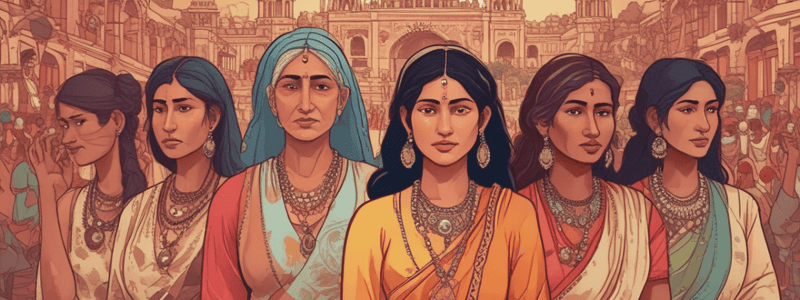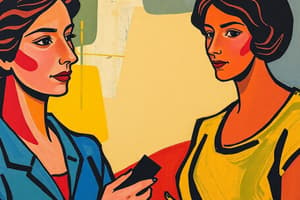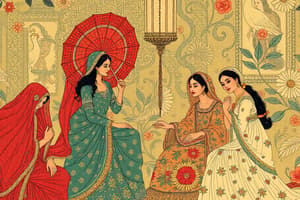Podcast
Questions and Answers
18th and 19th century India had the worst form of ______ evils when it comes to different stratas of society
18th and 19th century India had the worst form of ______ evils when it comes to different stratas of society
social
The British got the moral justification to stay in India saying they needed to ______ the Indians
The British got the moral justification to stay in India saying they needed to ______ the Indians
civilise
The ______ of social evil was shown to English educated Indians, who responded to these criticisms with socio-religious Reform movements
The ______ of social evil was shown to English educated Indians, who responded to these criticisms with socio-religious Reform movements
mirror
Jonathan Duncan tried to curb ______ by persuasion and monetary compensation
Jonathan Duncan tried to curb ______ by persuasion and monetary compensation
In 1802, the first major ______ known as regulation 6 made infanticide a major offence
In 1802, the first major ______ known as regulation 6 made infanticide a major offence
The ______ argue that the social evils prevalent in the Indian society are intrinsic to the religion, therefore we need to reform and develop a new form of religion
The ______ argue that the social evils prevalent in the Indian society are intrinsic to the religion, therefore we need to reform and develop a new form of religion
The ______ argue that the problems and social evils which exist in the current form of religion and Society are later editions and distortions to the original religious ideas
The ______ argue that the problems and social evils which exist in the current form of religion and Society are later editions and distortions to the original religious ideas
The condition of ______ was one of the worst social evils prevalent in 18th and 19th century India
The condition of ______ was one of the worst social evils prevalent in 18th and 19th century India
The problem lies in later ______ and practices so revive the original form of religion.
The problem lies in later ______ and practices so revive the original form of religion.
Raja Ram Mohan Roy developed the organisation ______ Samaj in 1815-1819.
Raja Ram Mohan Roy developed the organisation ______ Samaj in 1815-1819.
The main theme of Brahmo Samaj is ______ Sapna, one formless God.
The main theme of Brahmo Samaj is ______ Sapna, one formless God.
Devendra Nath Tagore employed ______ Sen to spread Brahmo Samaj across the country.
Devendra Nath Tagore employed ______ Sen to spread Brahmo Samaj across the country.
The first split of Brahmo Samaj resulted in Brahmo Samaj of India and ______ Brahmo Samaj.
The first split of Brahmo Samaj resulted in Brahmo Samaj of India and ______ Brahmo Samaj.
KC Sen supported a ban on ______ marriage, but he himself married his minor daughter to the king of Cooch Behar.
KC Sen supported a ban on ______ marriage, but he himself married his minor daughter to the king of Cooch Behar.
The second split of Brahmo Samaj resulted in ______ Brahmo Samaj, which still exists today.
The second split of Brahmo Samaj resulted in ______ Brahmo Samaj, which still exists today.
Brahmo Samaj believes in ______, challenging the caste notion and idol worship.
Brahmo Samaj believes in ______, challenging the caste notion and idol worship.
Arya Samaj was established in ____ by Dayanand Saraswati
Arya Samaj was established in ____ by Dayanand Saraswati
Lala Hansraj is the person behind the opening of ____ schools
Lala Hansraj is the person behind the opening of ____ schools
Arya Samaj had two branches, one of which is the ____ branch
Arya Samaj had two branches, one of which is the ____ branch
The word ____ was coined by Jyotiba Phule
The word ____ was coined by Jyotiba Phule
Jyotiba Phule started a school for ____ in Pune in 1851
Jyotiba Phule started a school for ____ in Pune in 1851
The aim of Satyashodhak Samaj was to liberate the ____ and untouchable castes from exploitation and oppression
The aim of Satyashodhak Samaj was to liberate the ____ and untouchable castes from exploitation and oppression
Jyotiba Phule started a home for pregnant widows of dominant ____ in 1875
Jyotiba Phule started a home for pregnant widows of dominant ____ in 1875
The Jaat Paat Todak Mandal was a ____ society
The Jaat Paat Todak Mandal was a ____ society
The Brahmo Samaj of India was taken forward by ______ but it ended with his death.
The Brahmo Samaj of India was taken forward by ______ but it ended with his death.
The founder of the Atmiya Sabha was ______.
The founder of the Atmiya Sabha was ______.
The Tatvbodhini Sabha was founded by ______.
The Tatvbodhini Sabha was founded by ______.
Henry Vivian Derozio was a ______ teacher at Hindu College.
Henry Vivian Derozio was a ______ teacher at Hindu College.
The followers of Henry Vivian Derozio were called ______.
The followers of Henry Vivian Derozio were called ______.
Ishwar Chandra Vidyasagar was a pioneer of ______ education.
Ishwar Chandra Vidyasagar was a pioneer of ______ education.
The Prathna Samaj was inspired by ______.
The Prathna Samaj was inspired by ______.
The Prathna Samaj was known for ______ one of the most important justices.
The Prathna Samaj was known for ______ one of the most important justices.
Shri Narayan Guru belonged to the ______ committee of Kerala
Shri Narayan Guru belonged to the ______ committee of Kerala
The main issue of Shri Narayan Guru was accessibility to God should not be the Monopoly of ______
The main issue of Shri Narayan Guru was accessibility to God should not be the Monopoly of ______
Shri Narayan Guru established the ______ Yogam
Shri Narayan Guru established the ______ Yogam
EV Ramasamy naikar aka ______ started the self respect movement
EV Ramasamy naikar aka ______ started the self respect movement
The movement started by Sir Syed Ahmed Khan in 1875 is known as ______ movement
The movement started by Sir Syed Ahmed Khan in 1875 is known as ______ movement
Wahabi movement was a ______ movement
Wahabi movement was a ______ movement
Sarda Act of 1929 was also known as ______ act
Sarda Act of 1929 was also known as ______ act
The magazine started by Sir Syed Ahmed Khan is known as ______
The magazine started by Sir Syed Ahmed Khan is known as ______
Flashcards are hidden until you start studying
Study Notes
Socio-Religious Reform Movements in 18th and 19th Century India
- Social evils prevalent in 18th and 19th century India included:
- Lack of access to education
- Gender inequality
- Superstition
- Sati (self-immolation of widows)
- Condition of widows
- Child marriage
- Female infanticide
- Dowry system
- Depressed class issues
- Untouchability
- Exploitation and oppression by upper castes
- Poverty and associated issues
- Lack of access to pilgrimage centers and common places
- Lack of social mobility
- Worst affected by natural disasters and disease outbreaks
Causes of Socio-Religious Reforms
- Existing social evils
- British moral justification to stay in India (White man's burden)
- Response of English-educated Indians to criticism of social evils
Legislative Reforms by the British
- Regulation 6 (1802): made infanticide a major offense
Reformist and Revivalist Movements
- Reformist movements:
- Argued that social evils were intrinsic to religion and needed to be reformed
- Examples: Atmiya Samaj, Brahmo Samaj, Ramkrishna Mission, Malabari, Pandita Ramabai, Prathna Samaj
- Revivalist movements:
- Argued that problems and social evils were distortions to original religious ideas and needed to be revived
- Examples: Jaat Paat Todak Mandal, Dharma Sabha, Arya Samaj
Atmiya Samaj/Brahmo Samaj
- Founded by Raja Ram Mohan Roy (1815-1819)
- Reformed form of Hinduism called Brahmoism
- Beliefs and practices:
- No idol worship
- Challenging caste notion
- Vedanta (Upanishads)
- Put an end to Sati and child marriage
- Formalized the organization (1828-1829)
Brahmo Samaj
- Successor organization to Atmiya Samaj
- Founded by Devendra Nath Tagore (1828)
- Employed KC Sen to spread Brahmo Samaj to various parts of the country
- Supported widow remarriage, inter-caste marriage, and inter-caste widow remarriage
- Splits in Brahmo Samaj:
- Brahmo Samaj of India (led by KC Sen)
- Aadi Brahmo Samaj (led by Devendra Nath Tagore)
Other Reform Movements
- Henry Vivian Derozio (1826-1831): teacher at Hindu College, radical for his times, opposed British colonialism
- Ishwar Chandra Vidyasagar: pioneer of girls' education, widow remarriage, and lower caste upliftment
- Prathna Samaj: offshoot of Brahmo Samaj in Maharashtra, founded by Dadoba Tarkadhkar and Atmaram Pandurang (1867)
- Arya Samaj: founded by Dayananda Saraswati, emphasized monotheism, social and cultural reforms, and rejected purana polytheism
- Lahore Branch and Gurukul Branch of Arya Samaj
- Jaat Paat Todak Mandal: revivalist movement, society for the abolition of caste
- Dharma Sabha: revivalist movement, against the abolition of Sati
- Jyotiba Phule: started Satyashodhak Samaj, aimed to liberate Shudra and untouchable castes from exploitation and oppression
- Shri Narayana Guru: stressed social and spiritual upliftment of the downtrodden, denounced Chaturvarna system
- EV Ramasamy Naikar (Periyar): started the self-respect movement
- Temple Entry Movement:
- Vaikom Satyagraha (1924): demanded throwing open of Hindu temples and roads to untouchables
- Sarda Act (1929): fixed the age of marriage for boys and girls
- Muslim Reform Movements:
- Sir Syed Ahmed Khan: started the Aligarh movement, promoted women's education and rights
- Wahabi Movement: revivalist movement, aimed to purify Islam of un-Islamic practices
Studying That Suits You
Use AI to generate personalized quizzes and flashcards to suit your learning preferences.




